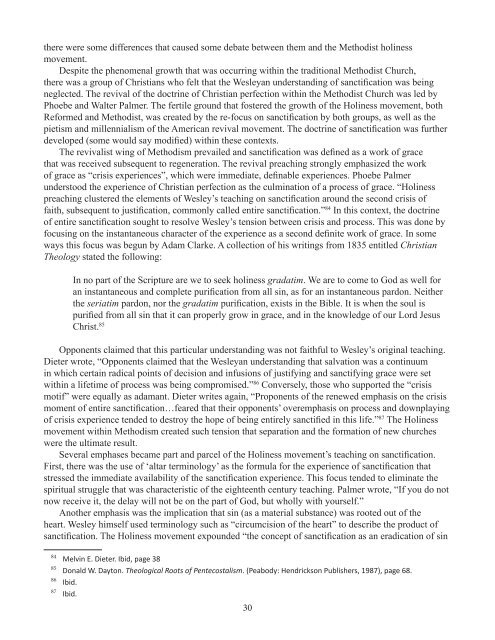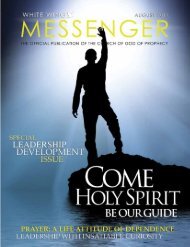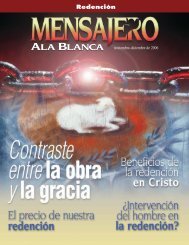The Pursuit of the Holy God - Church of God of Prophecy
The Pursuit of the Holy God - Church of God of Prophecy
The Pursuit of the Holy God - Church of God of Prophecy
You also want an ePaper? Increase the reach of your titles
YUMPU automatically turns print PDFs into web optimized ePapers that Google loves.
<strong>the</strong>re were some differences that caused some debate between <strong>the</strong>m and <strong>the</strong> Methodist holiness<br />
movement.<br />
Despite <strong>the</strong> phenomenal growth that was occurring within <strong>the</strong> traditional Methodist <strong>Church</strong>,<br />
<strong>the</strong>re was a group <strong>of</strong> Christians who felt that <strong>the</strong> Wesleyan understanding <strong>of</strong> sanctification was being<br />
neglected. <strong>The</strong> revival <strong>of</strong> <strong>the</strong> doctrine <strong>of</strong> Christian perfection within <strong>the</strong> Methodist <strong>Church</strong> was led by<br />
Phoebe and Walter Palmer. <strong>The</strong> fertile ground that fostered <strong>the</strong> growth <strong>of</strong> <strong>the</strong> Holiness movement, both<br />
Reformed and Methodist, was created by <strong>the</strong> re-focus on sanctification by both groups, as well as <strong>the</strong><br />
pietism and millennialism <strong>of</strong> <strong>the</strong> American revival movement. <strong>The</strong> doctrine <strong>of</strong> sanctification was fur<strong>the</strong>r<br />
developed (some would say modified) within <strong>the</strong>se contexts.<br />
<strong>The</strong> revivalist wing <strong>of</strong> Methodism prevailed and sanctification was defined as a work <strong>of</strong> grace<br />
that was received subsequent to regeneration. <strong>The</strong> revival preaching strongly emphasized <strong>the</strong> work<br />
<strong>of</strong> grace as “crisis experiences”, which were immediate, definable experiences. Phoebe Palmer<br />
understood <strong>the</strong> experience <strong>of</strong> Christian perfection as <strong>the</strong> culmination <strong>of</strong> a process <strong>of</strong> grace. “Holiness<br />
preaching clustered <strong>the</strong> elements <strong>of</strong> Wesley’s teaching on sanctification around <strong>the</strong> second crisis <strong>of</strong><br />
faith, subsequent to justification, commonly called entire sanctification.” 84 In this context, <strong>the</strong> doctrine<br />
<strong>of</strong> entire sanctification sought to resolve Wesley’s tension between crisis and process. This was done by<br />
focusing on <strong>the</strong> instantaneous character <strong>of</strong> <strong>the</strong> experience as a second definite work <strong>of</strong> grace. In some<br />
ways this focus was begun by Adam Clarke. A collection <strong>of</strong> his writings from 1835 entitled Christian<br />
<strong>The</strong>ology stated <strong>the</strong> following:<br />
In no part <strong>of</strong> <strong>the</strong> Scripture are we to seek holiness gradatim. We are to come to <strong>God</strong> as well for<br />
an instantaneous and complete purification from all sin, as for an instantaneous pardon. Nei<strong>the</strong>r<br />
<strong>the</strong> seriatim pardon, nor <strong>the</strong> gradatim purification, exists in <strong>the</strong> Bible. It is when <strong>the</strong> soul is<br />
purified from all sin that it can properly grow in grace, and in <strong>the</strong> knowledge <strong>of</strong> our Lord Jesus<br />
Christ. 85<br />
Opponents claimed that this particular understanding was not faithful to Wesley’s original teaching.<br />
Dieter wrote, “Opponents claimed that <strong>the</strong> Wesleyan understanding that salvation was a continuum<br />
in which certain radical points <strong>of</strong> decision and infusions <strong>of</strong> justifying and sanctifying grace were set<br />
within a lifetime <strong>of</strong> process was being compromised.” 86 Conversely, those who supported <strong>the</strong> “crisis<br />
motif” were equally as adamant. Dieter writes again, “Proponents <strong>of</strong> <strong>the</strong> renewed emphasis on <strong>the</strong> crisis<br />
moment <strong>of</strong> entire sanctification…feared that <strong>the</strong>ir opponents’ overemphasis on process and downplaying<br />
<strong>of</strong> crisis experience tended to destroy <strong>the</strong> hope <strong>of</strong> being entirely sanctified in this life.” 87 <strong>The</strong> Holiness<br />
movement within Methodism created such tension that separation and <strong>the</strong> formation <strong>of</strong> new churches<br />
were <strong>the</strong> ultimate result.<br />
Several emphases became part and parcel <strong>of</strong> <strong>the</strong> Holiness movement’s teaching on sanctification.<br />
First, <strong>the</strong>re was <strong>the</strong> use <strong>of</strong> ‘altar terminology’ as <strong>the</strong> formula for <strong>the</strong> experience <strong>of</strong> sanctification that<br />
stressed <strong>the</strong> immediate availability <strong>of</strong> <strong>the</strong> sanctification experience. This focus tended to eliminate <strong>the</strong><br />
spiritual struggle that was characteristic <strong>of</strong> <strong>the</strong> eighteenth century teaching. Palmer wrote, “If you do not<br />
now receive it, <strong>the</strong> delay will not be on <strong>the</strong> part <strong>of</strong> <strong>God</strong>, but wholly with yourself.”<br />
Ano<strong>the</strong>r emphasis was <strong>the</strong> implication that sin (as a material substance) was rooted out <strong>of</strong> <strong>the</strong><br />
heart. Wesley himself used terminology such as “circumcision <strong>of</strong> <strong>the</strong> heart” to describe <strong>the</strong> product <strong>of</strong><br />
sanctification. <strong>The</strong> Holiness movement expounded “<strong>the</strong> concept <strong>of</strong> sanctification as an eradication <strong>of</strong> sin<br />
84 Melvin E. Dieter. Ibid, page 38<br />
85 Donald W. Dayton. <strong>The</strong>ological Roots <strong>of</strong> Pentecostalism. (Peabody: Hendrickson Publishers, 1987), page 68.<br />
86 Ibid.<br />
87 Ibid.<br />
30

















